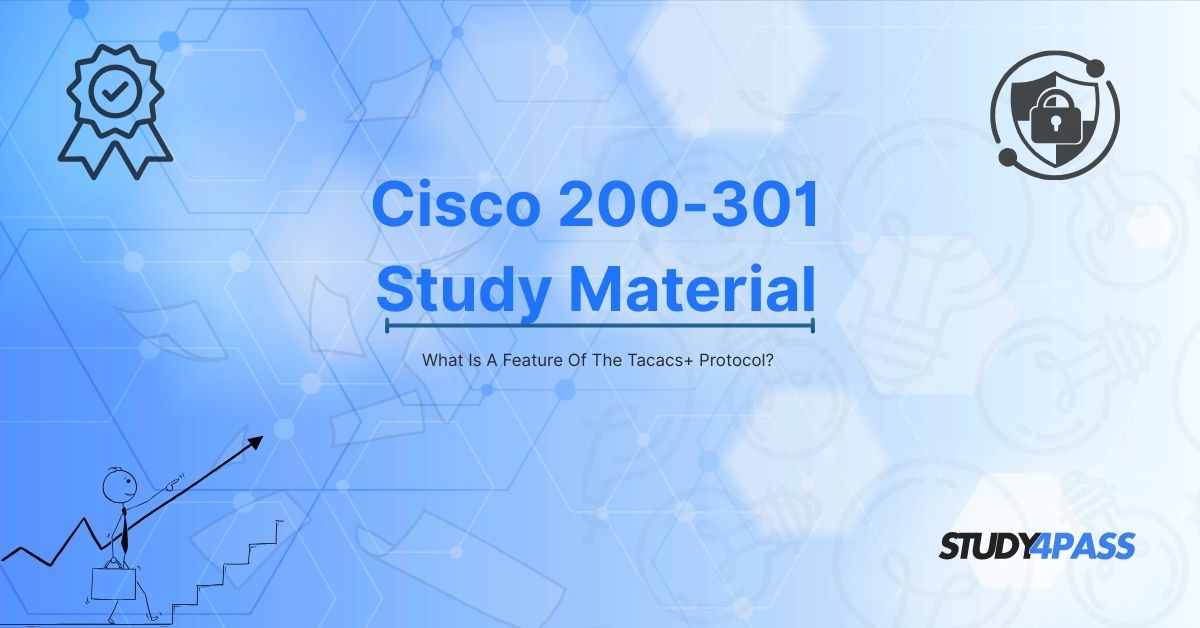Introduction to TACACS+
In the world of network security, authentication, authorization, and accounting (AAA) protocols play a crucial role in ensuring secure access to network devices. One such protocol is TACACS+ (Terminal Access Controller Access-Control System Plus), which is widely used in enterprise environments for managing user access to routers, switches, and other network infrastructure.
For students preparing for the CCNA Cyber Ops (v1.1) Exam or the Cisco 200-301 Certification, understanding TACACS+ is essential. This article will explore a key feature of the TACACS+ protocol, its importance in network security, and how Study4Pass can help you master these concepts effectively.
What Is TACACS+?
TACACS+ is a Cisco proprietary protocol designed to provide centralized AAA services for network devices. Unlike its predecessor, TACACS, which only offered authentication, TACACS+ separates authentication, authorization, and accounting into distinct processes, offering greater flexibility and security.
Key Feature of TACACS+: Separation of AAA Functions
One of the most significant features of TACACS+ is its separation of authentication, authorization, and accounting (AAA) functions. This modular approach allows network administrators to implement each function independently, providing fine-grained control over user access and activity logging.
1. Authentication
- TACACS+ verifies user credentials (username and password) before granting access.
- It supports multiple authentication methods, including CHAP (Challenge Handshake Authentication Protocol) and PAP (Password Authentication Protocol).
- Authentication requests are encrypted, ensuring secure communication between the client and the TACACS+ server.
2. Authorization
- After authentication, TACACS+ determines what resources or commands a user can access.
- Administrators can define granular permissions, such as allowing certain users to execute specific commands on a router while restricting others.
- This feature enhances security by enforcing the principle of least privilege.
3. Accounting
- TACACS+ logs user activities, including login attempts, commands executed, and session duration.
- Accounting data helps in auditing and compliance, allowing administrators to track suspicious activities.
This separation makes TACACS+ more flexible and secure compared to other AAA protocols like RADIUS, which combines authentication and authorization.
Why Is TACACS+ Important for the CCNA Cyber Ops & Cisco 200-301 Exams?
Both the CCNA Cyber Ops (v1.1) Exam and the Cisco 200-301 Certification emphasize network security concepts, including AAA protocols. Understanding TACACS+ is crucial because:
- Enterprise Networks Rely on TACACS+ – Many organizations use TACACS+ for secure device administration.
- Granular Access Control – Unlike RADIUS, TACACS+ allows command-level authorization, a key topic in Cisco exams.
- Security Best Practices – Knowing how TACACS+ encrypts the entire packet (unlike RADIUS, which only encrypts passwords) is vital for security-focused roles.
Mastering TACACS+ will help you answer exam questions related to:
- AAA configuration on Cisco devices
- Differences between TACACS+ and RADIUS
- Network access control and auditing
How Study4Pass Helps You Master TACACS+ and Cisco Certifications?
Preparing for Cisco exams requires high-quality study materials and practice tests. Study4Pass is an excellent platform that offers:
- Comprehensive Study Guides – Detailed explanations of TACACS+, RADIUS, and other network security topics.
- Real Exam Simulations – Practice tests that mimic the CCNA Cyber Ops and Cisco 200-301 exams.
- Expertly Crafted Content – Easy-to-understand materials designed by networking professionals.
- Up-to-Date Resources – Study4Pass ensures all content aligns with the latest exam objectives.
By using Study4Pass, you can confidently prepare for your certification exams, ensuring a deep understanding of TACACS+ and other critical networking concepts.
Final Thoughts
TACACS+ is a powerful AAA protocol that provides separate authentication, authorization, and accounting functions, making it a preferred choice for secure network administration. For aspiring network professionals preparing for the CCNA Cyber Ops (v1.1) Exam or Cisco Certification, mastering TACACS+ is essential.
Study4Pass offers the best resources to help you succeed in your certification journey. With expertly designed study materials and practice exams, Study4Pass ensures you are fully prepared to tackle any question related to TACACS+ and beyond.
Start your preparation today with Study4Pass and take the first step toward becoming a Cisco-certified networking expert!
Special Discount: Offer Valid For Limited Time “Cisco CCNA 200-301 Practice Test”
Actual exam question from Cisco's 200-301 Exam Prep Practice Test.
Sample Questions for Cisco 200-301 Exam Prep
1. Which of the following best describes TACACS+?
A) A protocol that only handles authentication
B) A Cisco proprietary protocol that separates authentication, authorization, and accounting
C) A Microsoft-developed protocol for Windows environments
D) A UDP-based protocol for lightweight AAA services
2. How does TACACS+ differ from RADIUS in terms of communication?
A) TACACS+ uses UDP, while RADIUS uses TCP
B) TACACS+ uses TCP, while RADIUS uses UDP
C) Both use UDP for faster communication
D) Both use TCP for reliable connections
3. What type of encryption does TACACS+ use for its packets?
A) No encryption, only hashing
B) Full packet encryption
C) Only encrypts the password field
D) Uses SSL/TLS for encryption
4. Which AAA function does TACACS+ handle separately from the others?
A) Authentication, authorization, and accounting are combined
B) Only authentication and authorization are separate
C) Authentication, authorization, and accounting are all separate processes
D) Only accounting is separate
5. Why might an administrator choose TACACS+ over RADIUS?
A) Because it is an open standard
B) Because it provides more granular control over authorization commands
C) Because it uses UDP for faster communication
D) Because it does not encrypt traffic


